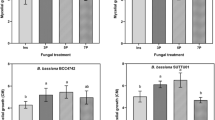Abstract
The two-spotted spider mite (TSSM) Tetranychus urticae is one of the most important pests of cucurbit plants. If TSSM can act as vector for Acidovorax citrulli (Acc), causal agent of bacterial fruit blotch (BFB), then the movement of mites from infected to healthy plants may represent a potential source of inocula for BFB outbreaks. To confirm the association between Acc and TSSM, we generated a green fluorescent protein-tagged mutant strain (Acc02rf) by transposon mutagenesis and demonstrated that TSSM can transmit Acc from infected to non-infected watermelon plants. Challenge with 10 TSSMs carrying Acc02rf population densities of 1.3 × 103 CFU each on freshly grown individual watermelon plants caused disease transmission to 53 %. Incubation periods ranged 7–9 days. Bacteria recovered from symptoms typical of those associated with leaf necrosis were characterized and identified as Acc. To our knowledge, this is the first report showing that TSSM can be a vector of Acc. The results reported here support that the strong association of TSSM with Acc is of particular importance in controlling BFB.


Similar content being viewed by others
References
Basset A, Tzou P, Lemaitre B, Boccard F (2003) A single gene that promotes interaction of a phytopathogenic bacterium with its insect vector, Drosophila melanogaster. EMBO Rep 4:205–209
Bridges JR (1981) Nitrogen-fixing bacteria associated with bark beetles. Microbial Ecol 7:131–137
Burdman S, Walcott R (2012) Acidovorax citrulli: generating basic and applied knowledge to tackle a global threat to the cucurbit industry. Mol Plant Pathol 13:805–815
Dillon RJ, Charnley AK (1995) Chemical barriers to gut infection in the desert locust: in vivo production of antimicrobial phenols associated with the bacteria Pantoea agglomerans. J Invertebr Pathol 66:72–75
Dutta B, Scherm H, Gitaitis RD, Walcott RR (2012) Acidovorax citrulli seed inoculum load affects seedling transmission and spread of bacterial fruit blotch of watermelon under greenhouse conditions. Plant Dis 96:705–711
Gitaitis RD, Walcott RR, Wells ML, Perez JCD, Sanders FH (2003) Transmission of Pantoea ananatis, causal agent of center rot of onion, by tobacco thrips, Frankliniella fusca. Plant Dis 87:675–678
Harada H, Oyaizu H, Ishikawa H (1996) A consideration about the origin of aphid intracellular symbiont in connection with gut bacterial flora. J Gen Appl Microbiol 42:17–26
Ho CC (2000) Spider mite problems and control in Taiwan. Exp Appl Acarol 24:453–462
Hopkins DL, Thompson CM (2002) Seed transmission of Acidovorax avenae subsp. citrulli in cucurbits. HortScience 37:924–925
Isakeit T, Black MC, Jones JB (1998) Natural infection of citronmelon with Acidovorax avenae subsp. citrulii. Plant Dis 82:351
Latin RX, Hopkins DL (1995) Bacterial fruit blotch of watermelon: the hypothetical exam question becomes reality. Plant Dis 79:761–765
Leach JG (1964) Observations on cucumber beetles as vectors of cucurbit wilt. Phytopathology 54:606–607
Lloyd AC, Drew RA, Teakle DS, Hayward AC (1986) Bacteria associated with some Dacus species (Diptera: Tephritidae) and their host fruit in Queensland. Aust J Biol Sci 39:361–368
Longston DB Jr, Walcott RR, Gitaitis RD, Sanders FH Jr (1999) First report of a fruit rot of pumpkin caused by Acidovorax avenae subsp. citrulli in Georgia. Plant Dis 83:199
MacCollom GB, Lauzon CR, Payne EB, Currier WW (1994) Apple maggot (Diptera: Tephritidae) trap enhancement with washed bacterial cells. Environ Entomol 23:354–359
Martin HL, O′Brien RG (1999) First report of Acidovorax avenae subsp. citrulli as a pathogen of cucumber. Plant Dis 83:965
Mead LJ, Khachatourians GG, Jones GA (1988) Microbial ecology of the gut in laboratory stocks of the migratory grasshopper, Melanoplus sanguinipes (Fab.) (Orthoptera: Acrididae). Appl Environ Microbiol 54:1174–1181
Miresmailli S, Bradbury R, Isman MB (2006) Comparative toxicity of Rosmarinus officinalis L. essential oil and blend of its major constituents against Tetranychus urticae Koch (Acari: Tetranychidae) on two different host plants. Pest Manag Sci 62:366–371
Pérombelon MCM, Kelman A (1980) Ecology of the soft rot Erwinia. Annu Rev Phytopathol 18:361–387
Potrikus CJ, Breznak JA (1977) Nitrogen-fixing Enterobacter agglomerans isolated from guts of wood-eating termites. Appl Environ Microbiol 33:392–399
Raworth DA (2001) Development, larval voracity, and greenhouse releases of Stethorus punctillum (Coleoptera: Coccinellidae). Can Entomol 133:721–724
Schaad NW, Sowell G, Goth RW, Colwell RR, Webb RE (1978) Pseudomonas pseudoalcaligenes subsp. citrulli subsp. nov. Int J Syst Bacteriol 28:117–125
Simon R, Priefer U, Puhler A (1983) A broad host range mobilization system for in vivo genetic engineering: transposon mutagenesis in gram-negative bacteria. Bio/Technology 1:784–791
Suarez A, Guttler A, Stratz M, Staendner LH, Timmis KN, Guzman CA (1997) Green fluorescent protein-based reporter systems for genetic analysis of bacteria including monocopy applications. Gene 196:69–74
Takafuji A, Ozawa A, Nemoto H, Gotoh T (2000) Spider mites of Japan: their biology and control. Exp Appl Acarol 24:319–335
Wells ML, Gitaitis RD, Sanders FH (2002) Association of tobacco thrips, Frankliniella fusca (Thysanoptera: Thrpidae) with two species of bacteria of the genus Pantoea. Ann Entomol Soc Am 95:719–723
Woods TL, Israel HW, Sherf AF (1981) Isolation and partial characterization of a bacteriophage of Erwinia stewartii from the corn flea beetle Chaetocnema pulicaria. Prot Ecol 3:229–236
Zhang ZQ (2003) Mites in greenhouse: identification, biology and control. CABI Publishing Press, Cambridge, p 235
Acknowledgments
This research was supported by Basic Science Research Program through the National Research Foundation of Korea (NRF) funded by the Ministry of Education (2015R1A6A1A03031413).
Author information
Authors and Affiliations
Corresponding author
Rights and permissions
About this article
Cite this article
Choi, O., Park, JJ. & Kim, J. Tetranychus urticae (Acari: Tetranychidae) transmits Acidovorax citrulli, causal agent of bacterial fruit blotch of watermelon. Exp Appl Acarol 69, 445–451 (2016). https://doi.org/10.1007/s10493-016-0048-z
Received:
Accepted:
Published:
Issue Date:
DOI: https://doi.org/10.1007/s10493-016-0048-z




